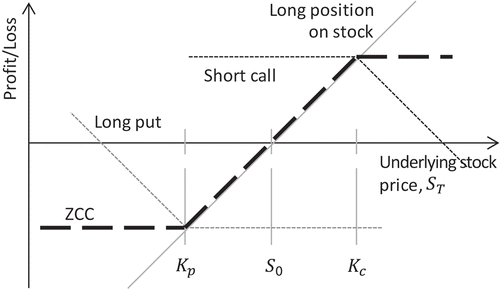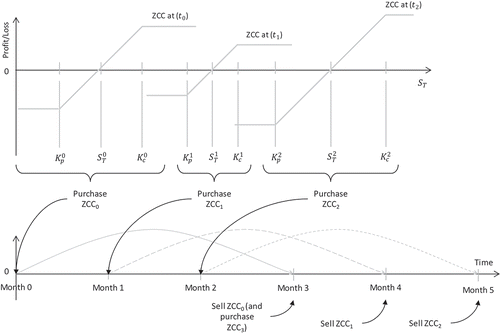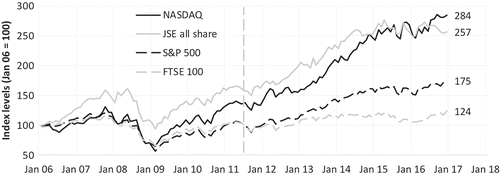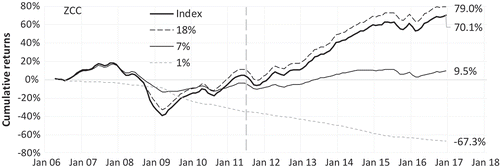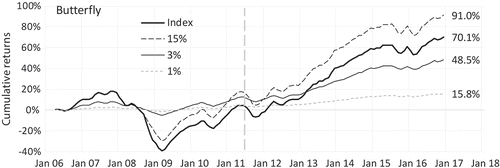 ?Mathematical formulae have been encoded as MathML and are displayed in this HTML version using MathJax in order to improve their display. Uncheck the box to turn MathJax off. This feature requires Javascript. Click on a formula to zoom.
?Mathematical formulae have been encoded as MathML and are displayed in this HTML version using MathJax in order to improve their display. Uncheck the box to turn MathJax off. This feature requires Javascript. Click on a formula to zoom.Abstract
Zero-cost collars are option-based strategies which—by matching prices received and paid for the component derivatives—provide costless protection for stock or index investments. The investors’ risk appetite determines a return floor by selecting a relevant put strike and the associated call strike (reverse-engineered from the [known] call value) establishes the index return’s cap. Increasing the floor increases the cap and vice versa. A butterfly strategy involves the purchase of two call options and the sale of two put options. By choosing appropriate strikes, this assembly may also be structured such that it provides a costless investment strategy. Rolling strategies involve the purchase and later sale of the derivative components at a chosen frequency (usually monthly): but the literature has, to date, not explored the potential outcomes for such procedures. Using recent historical data, the effect of different strategy maturities and strike prices on potential index returns (from several jurisdictions) are investigated. The more profitable strategy is strongly influenced by the prevailing market conditions.
PUBLIC INTEREST STATEMENT
Zero-cost collars are option-based strategies which match prices received and paid for constituent derivatives, thereby providing costless protection. Investors’ risk appetite determines a loss limit and the associated call strike establishes the index return’s cap. Increasing the floor increases the cap and vice versa. A butterfly strategy requires the purchase of two call options and the sale of two put options: selecting appropriate strikes allows this assembly to also provide a costless investment strategy. Rolling strategies involve the purchase and later sale of the derivative components at a chosen frequency. The literature has, however, not explored the potential outcomes for such procedures to date (June 2018). Using recent historical data, the effect of different strategy maturities and strike prices on potential index returns (from developed and developing markets) are investigated.
The research shows that profitable strategies are strongly influenced by prevailing market conditions and financial milieu. These effects are calibrated in this article. This research may be applied to any jurisdiction which employs zero-cost derivative strategies and market period (bull or bear).
1. Introduction
An options-based zero-cost collar (ZCC) is a cost-efficient way to protect stock gains by limiting potential losses (Arunajith, Citation2007). The strategy, which involves the purchase of a put and the simultaneous sale of a call, provides the call buyer the right to purchase a given stock at a set price (which creates a cap above the current price) while, to restrict losses, the put installs a floor under the current price of the stock. ZCCs provide the most efficient strategy for bullish investors, i.e. those who believe the underlying stock will continue to gain value. The put strike—or loss limit—is thus usually set first, depending on the investor’s risk appetite, then the call strike price is determined in such a way as to generate enough for the put purchase. This renders the entire transaction cost-free. This option-based strategy allows investors to hedge their investment while still maintaining profit potential (Gordon, Citation2015).
Rolling ZCCs comprise numerous individual ZCCs, rolled forward consecutively at a chosen frequency—usually one month. Such collars are constructed with the same maturity and time to expiry, so, for example, a three-month ZCC could be purchased each subsequent month, and at the end of the first three-month period, the first collar is closed, then the second collar closed one month later, and so on. The performance of the collar is determined using returns generated from the strategy and comparing these to a relevant market index.
A long butterfly (LB) is a non-directional option-based strategy designed to earn a limited profit (but with limited risk) when the future volatility of the underlying asset is different from the implied volatility (Kolton, Citation2009). The LB is assembled using a combination of four option contracts with three different strike prices, but with the same maturities. Two call options are sold at a strike price between the strike price of two long calls. This assembly of strike prices provides profit opportunities from a range of prices: the strikes are determined based on investor risk appetite and prevailing market conditions such as liquidity and volatility. Since the LB involves the purchase and sale of options, these constituent options can also—like the ZCC—be structured in such a way as to ensure the strategy incurs no costs.
Rolling LBs are compiled when numerous single LBs are rolled forward at the investor-determined frequency. The rolling LB is then entered with the same maturity dates and time to expiry. For example, a three-month LB may be taken on every subsequent month. The first LB is closed out at the end of a three-month period, the second a month later and so on until the end of the investment horizon.
This study aims to understand the performance of rolling ZCCs and LBs under different market conditions and in different geographies to provide an understanding of the dynamics of the strategies. The principal variables are put strike percentages which are user-defined in practice and are used in the ZCC and LB to balance associated call strikes such that both strategies incur no costs.
This remainder of this article proceeds as follows. A brief literature review is presented in Section 2 which provides insight into the ZCC and LB strategies and previous work on the topic. Being an investment strategy, neither ZCC and LB have been the focus of fevered academic investigation, so literature on the subject is somewhat limited to generic option theory and performance measurement. The data used in the study and the methodology create the ZCC and LB models which are given in Section 3 and the results obtained presented and discussed in Section 4. Section 5 concludes.
2. Literature review
2.1. Zero-cost collars
A ZCC is a derivative strategy which implements a put and a call option to protect a stock (or equity index) by limiting upside and downside risk. The price of these options is equal and therefore the strategy is costless. An investor holds the underlying stock, a long put option on the stock and a short call option on the stock (Bartoňová, Citation2012). The price received for the short call and the price paid for the long call are designed to be identical (by adjusting the put strike) so procuring the collar costs the investor nothing, other than the initial purchase of the stock (which the investor may already own). This strategy is not limited to individual shares: it may also be implemented on entire equity indices (Dubil, Citation2010).
Overby (Citation2015) describes the strategy as implementing a protective put and a covered call. The protective put limits the downside losses, but at no cost as the cost of buying the put is paid for by the cost of selling the call. The covered call limits the upside returns and the put limits the downside risk at no cost by sacrificing profits should the stock price rise above the call strike price. The strategy is preferred by investors who wish to protect their profits from a decline in the stock’s returns after they have accumulated a desired level of positive returns: the strategy is favourable to retirement funds where protecting the fund’s capital is important (Shah, Citation2013). Kaur and Rattol (Citation2016) apply the ZCC strategy to hedge commodity exposures.
Arunajith (Citation2007) and Bartoňová (Citation2012) liken this strategy to a costless insurance policy. As the investor is not paying (effectively) for this insurance policy, significant benefits are unlikely and only the “bare minimum” cover is received. The strategy assists those with stock to reduce the risk of a downturn without selling the stock, and losing voting or dividend opportunities, and avoids certain tax implications (Braddock, Citation1997). This is particularly true in cases where the stock has significantly increased in value and protection is opportune to protect that wealth realised. An expired ZCC may be re-instituted under the new market conditions, but ZCCs take time to set up (usually about ten days to two weeks (Braddock, Citation1997)). Either the strike price of the call or the put is set which limits the upside or downside returns, respectively. A spread is therefore created from the option positions once the call and put prices are adjusted accordingly. Feldstein (Citation2009) notes that the tails of the collar can be tailored depending on the specifics of the put and call involved. A risk averse investor would sacrifice the profit of a stock increase above a relatively low strike price to be better protected from a negative return at a higher strike price below the stock price as shown in Figure .
The investor holds or buys the stock (long position): represented by 45° angle dashed black line, with value . Increases and decreases in the stock price at maturity lead to profits and losses, respectively, in this value. Changes of stock price are represented along the horizontal axis,
, the spot price. A long put is purchased at some strike price,
, below the stock price (determined by the investor’s risk appetite). This put, along with the stock held, limits the downside risk when the stock price falls below the put strike price (Hull, Citation2012). The investor exercises the put when the stock price falls below the put strike price to make a profit, so the profit negates losses made on the value of the stock. Above the put strike price, the put is left to expire as exercising it would result in greater losses (so the loss in this case is the cost of the put and the overall return is the decreased value of the stock minus the cost of the put).
A short call is also instituted: the call sale value must offset the cost of purchasing the put. The strike price of the call, , is thus dependant on the put price which is ultimately dependant on the put strike price. When the stock price is below the call strike price, but above the put strike price, the call owner allows the call to expire and the stock’s market return is obtained. When the stock price rises above the call strike price, the value of the call declines depending on the extent of the rise of the stock since the owner exercises the call above this point (Hill, Citation1997). The effect with stock being held is that below the strike price, the return is the stock price returns plus the call price, while above the strike price, the losses of the call being exercised cancels out the profits of the stock price increase creating a constant return. This return is the stock’s return at the point of the strike price plus the cost of the call (Schmock, Shreve, & Wystup, Citation2002).
These three elements create the collar. The costs of the options involved are irrelevant in terms of return since the cost of selling the call pays for the cost of purchasing the put. The collar limits losses below the put strike price to the loss from the initial stock price to that strike price—known as the floor. It also limits the gains above the call strike price to the gains from the initial stock price to that strike price (called the cap). In between these strike prices, with the values of the put and call cancelling, the profit is the value of the stock held. Over-the-counter maturities are often three months, so the maturity of most ZCCs are also three months, though six-month maturities are not uncommon (Ilhan, Jonsson, & Sircar, Citation2005).
2.2 Rolling collar
Rolling ZCC strategies may be used to implement longer term maturity investments. This is accomplished by (for example) buying the three-month put, selling the three-month call option monthly. Along with the put and call agreements, the investor buys the stock at the start of this agreement (subsequently sold at maturity): but this entire strategy is replicated—at different put and call strikes as the market changes monthly. At the end of each month a new collar, comprising a long put, long stock and short call, is entered into for the next three months. At the end of the first three months, the collar matures, and the returns are determined. Returns are measured every following month when each three-month date to maturity collar matures. Figure shows this process.
2.3 Butterfly
The LB is a derivative strategy which can be compiled by selling two call option contracts and then also buying one call option contract with a higher strike price and buying one call option contract with a lower strike price, as shown in Figure .
Figure 3. LB construction using four call option contracts with three different strike prices and a long stock position. is the strike price of the first long call option,
is the strike price of the second long call option and
is the strike price of the two short call options.
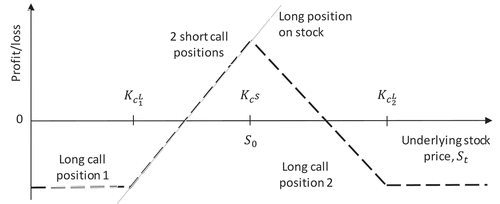
The two option contracts that have been bought with the higher and lower strike prices are the “wings” of the butterfly strategy. For the strategy to be affective, the two option contracts that have been bought must be equidistant to the two option contracts sold with the middle strike price (the body of butterfly). The investor only earns profits when the price of the stock or index reaches a certain value at maturity (Hammond, Citation2012). Investors use this strategy (which is not limited to shares, but may also be used to hedge against unfavourable equity index levels) as a hedge against losses. The choice of strike price determines when the option is in, at or out-of-the-money (Hammond, Citation2012).
Dawson, Dowd, Cairns, and Blake (Citation2010) include the butterfly strategy in their description of “survivor derivatives” and derive a consistent pricing framework them. Fernandesa, Gomesa, Vasconcelosa, and Brandãoa (Citation2015) employ the butterfly strategy to mitigate wind exposure.
The rolling LB strategy may be used to create and implement a longer term of maturity investment for the speculator: Figure shows this derivative strategy evolving on a monthly time frame.
Figure 4. The mechanism for constructing the rolling butterfly strategy. Strike prices are different for subsequent investment periods.
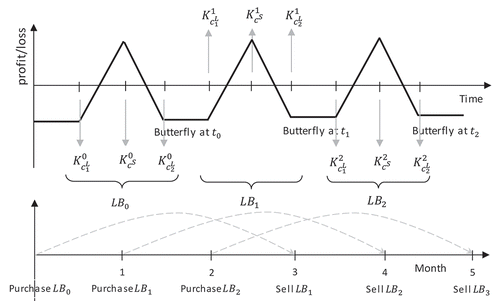
This longer term investment is reached (for example) by buying a three-month call option contract with the lower strike price at-the-money, selling two three-month call option contracts at-the-money with a strike price equal to the underlying assets price, and then finally buying a three-month call option contract that has a higher strike price that is in-the-money, monthly. Alongside this derivative strategy, the investor will also buy the underlying stock or asset at the start of the agreement (will be sold subsequently at maturity). This strategy may be replicated monthly, in a similar way to the ZCC. The returns are calculated at the end of each LB’s maturity.
is the strike of the first long call,
is the strike of the two short calls and
is the strike of the first long call all measured at time 0.
is the long butterfly strategy at time
and so on.
3. Data and methodology
3.1 Data
The data used in this report span an 11-year period from January 2006 to December 2016. This period was chosen to include the highly turbulent financial crisis of 2008/9 (a bearish period from January 2006 to June 2011) and a post-crisis period characterised by bullish growth (July 2011–December 2016). Stock indices from three different stock exchange countries were chosen for comparison:
The S&P500 (Standard & Poor’s 500): a US index comprising 500 large companies, weighted by factors such as size and liquidity, which have common stock on the NYSE (New York Stock Exchange) or NASDAQ. The S&P500 is widely considered to be the best representation of the US stock market.
The NASDAQ 100 Composite Index (NASDAQ 100): another US index includes 100 of the largest non-financial securities listed on the NASDAQ stock exchange based on market capitalisation. The NASDAQ 100 is heavily weighted towards information technology companies and is thus used as an indicator of technology stock performance rather than of the market as a whole.
The Johannesburg Stock Exchange All Share Index (JSE ALSI): a South African equity index containing top listed companies weighted by factors such as size and liquidity. The JSE is the nineteenth largest stock exchange and largest by market capitalisation in Africa (JSE, Citation2017). Adding an African all share index which reflects the equity market movements of South Africa provides diversification to the data pool.
The Financial Times Actuaries 100 Index (FTSE 100): a UK index comprising 100 blue chip stocks, including international companies, which trade on the London Stock Exchange (LSE). The LSE is the second largest stock exchange in Europe by market capitalisation and is commonly used as a UK and global equity benchmark.
These indices were chosen to provide a representation of developed and emerging markets (MSCI, Citation2011; PIMCO, Citation2015).
The underlying volatility is calculated using the implied exponential weighted moving average (EWMA) volatility of the respective volatility indices, so the Chicago Board Options Exchange (CBOE) Volatility Index (VIX) was used for the US indices (CBOE, Citation2017): the JSE’s South African Volatility Index (SAVI)—modelled on the VIX—is used for the developing market index (JSE, Citation2017) and the FTSE Implied Volatility Index Series (IVI) is used for the UK index (FTSE, Citation2017).
JP Morgan (Citation1996) describe the EWMA model which uses a combination of historical and implied volatility forecasts. This uses an exponential moving average to make recent historical values more significant in determining the volatility. The equation used to determine the EWMA volatility is:
where is the volatility at time
,
is the decay factor,
is the volatility for the previous time frame and
is the percentage return for that time frame, for which the volatility is being calculated.
Average annual dividend yields were assembled from the respective index data providers.
Risk-free rates are those commonly used in the countries where the index operates. The three risk-free rates used for the four indices are: the Federal Funds Rate for the S&P500 and the NASDAQ in the US, the Johannesburg Interbank Agreed Rate (JIBAR) in South Africa and in the UK, the three-month London Interbank Offer Rate (LIBOR).
All options’ maturities, , were three months. Although other maturities are possible in principle, these are uncommon in practice (Bartoňová, Citation2012).
Dividends paid out affect option prices. To account for this, dividends are removed from the index level, , as an investment. This amount is calculated using:
where α is the dividend percentage. This depreciates the value of the dividend, paid at maturity, to the commencement date of the option, which is then subtracted from the stock index price, .
Nominal index levels were calculated to give comparable, standardised representations, using , where
is the current stock price and
is the initial stock price at which the collar was instituted.
3.2 Methodology
For the ZCC, the put strike price, , is adjusted by choosing θ (a percentage below the stock price,
) using
. This, if the put strike is 5% and the index level 200, then the strike price,
, is
. In practice, this is determined by the ZCC purchaser’s risk appetite. In this implementation, a variety of possible values—representing different risk appetites—were selected.
For the LB, the strike price of the first long call (with the lower strike) is chosen (as with the ZCC) as a percentage below the index price at the strategy’s institution. This value is then altered to explore the behaviour of the transaction under different conditions. The two short call strikes are set to , i.e. the level of the index at the inception of the strategy.
Call and put option prices for both derivative strategies were calculated using (respectively):
and
where is the call price,
is the put price,
is the stock price,
is the strike price of the call,
is the strike price of the put,
is the risk-free rate of return,
is the time to expiration,
is the normal distribution of the value for
, and
and
are given by:
and
where is the strike price for the put or call depending on which is being calculated,
is the volatility of the stock (Black & Scholes, Citation1973). Note that for both strategies,
months and
,
and
are obtained from historical data.
(for the ZCC) and
(for the BL) are dependent on the variable
, which is adjusted for various values to ascertain the effect of the put strike (for the ZCC) and the first long call strike (for the BL) on the strategy’s performance.
For the ZCC, the call price (for the ZCC) is calculated using (1) and a value of which sets
.
For the BL, the second long call price is determined using (1) and a which sets
where
is the call price of the first long call,
is the call strike of the two short calls and
is the call pirce of the second long call. Floor and cap limits and strategy returns are summarised in Table .
Table 1. Summary of strategy returns
4. Results
The 11-year period chosen for this analysis was characterised by a highly turbulent period (dominated by the 2008/9 financial crisis and its aftermath) and a period of relatively non-volatile growth as shown in Figure . The dashed vertical line demarcates the two regions.
The performance of the indices vary considerably. The JSE all share index grew the strongest prior to the crisis and was least affected by it. Post crisis, the JSE’s growth continued, reaching a plateau in 2015. The NASDAQ has shown robust growth since the crisis. It has trebled in value since 6 January and continues apace. The S&P 500 and FTSE 100 have not increased much over the period, ending the period only 75% up and 25% up, respectively, since 6 January. Annualised growth rates for the period under investigation are: NASDAQ: 10.0%, JSE: 8.9%, S&P 500: 5.2% and FTSE: 2.0%.
The performance of both the ZCC and the LB investment strategies were then examined, for each index, over both periods. Figures and show the cumulative returns of the ZCC strategy (with different ) and the LB strategy (with different
), respectively, with the S&P 500 index as the underlying index. The level of market volatility was 25%. Figures and are included to reveal more detail than that provided in Figures and (Figure is, effectively, a cross section of Figures and Figure is an effective cross section of —both at
). For clarity, only the two strategies’ performance with the S&P 500 as underlying are shown.
Figure 8. Cumulative returns for a ZCC using the JSE all share as underlying, as a function of annual market volatility and strike levels (a) during crisis and (b) post crisis. Cumulative returns for a ZCC using the FTSE 100 as underlying, as a function of annual market volatility and strike levels (c) during crisis and (d) post crisis. Cumulative returns for a ZCC using the S&P 500 as underlying, as a function of annual market volatility and strike levels (e) during crisis and (f) post crisis. Cumulative returns for a ZCC using the NASDAQ as underlying, as a function of annual market volatility and strike levels (g) during crisis and (h) post crisis.
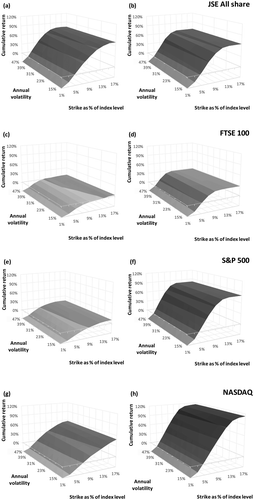
Figure 9. Cumulative returns of the ZCC as a function of strike levels (a) during crisis and (b) post crisis for .
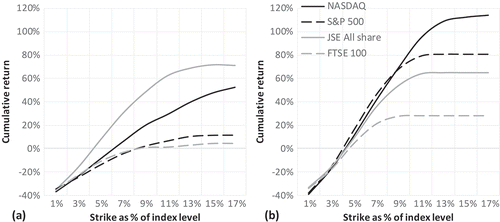
Figure 10. Cumulative returns for a LB using the JSE all share as underlying, as a function of annual market volatility and strike levels (a) during crisis and (b) post crisis. Cumulative returns for a LB using the FTSE 100 all share as underlying, as a function of annual market volatility and strike levels (c) during crisis and (d) post crisis. Cumulative returns for a LB using the S&P 500 all share as underlying, as a function of annual market volatility and strike levels (e) during crisis and (f) post crisis. Cumulative returns for a LB using the NASDAQ all share as underlying, as a function of annual market volatility and strike levels (g) during crisis and (h) post crisis.
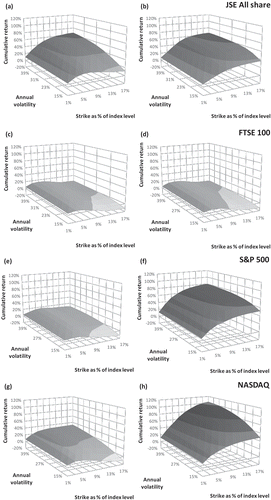
The ZCC strategy’s performance improves as the strike level increases. For low ,
is of similar magnitude so, although the strategy is protected from market downturns, the investor cannot enjoy high returns when the market improves. Thus, although the 1% strike ZCC strategy in Figure is protected from the worst of the financial crisis in 2008/9, outperformance never materialises as losses accumulate after the crisis with no associated index growth. As
increases, the strategy improves until it even outperforms the underlying index itself. This is principally because such a strategy was protected from the full impact of the 2008/9 crisis, and then enjoyed the strategy’s flexibility on upside performance. Note that eventually, when
is as large as the worst monthly return registered in the crisis, the ZCC strategy will mimic the index exactly.
The LB’s performance also improves as increases. The low call strike of 1% does not result in negative cumulative performance as it does for the ZCC. This is because the LB strategy benefits from market moves in both directions, i.e. increases and decreases, albeit constrained by the value of
. Hence, even for small
, the strategy manages a 16% cumulative performance over 11 years. For larger
, the strategy performance improves and then surpasses that of the index. Note, like the ZCC strategy, at some level of
, the strategy will mimic the index performance exactly as the strikes fall outside the maximum and minimum returns measured over the observation period.
The cumulative return of each strategy, for each underlying index, during and post the crisis, were explored next. Figures and 1 were produced by calculating the strategy performance (a) during the crisis period and (b) for 5.5 years post-crisis over various strikes and at different market volatility levels, . The
levels are subjective and dependent upon the measurement technique used (standard deviation, EWMA, GARCH); these values are not directly observable in the market.
Figure )–(h) shows the cumulative ZCC strategy performance for the various indices measured over different and
. Note that the cumulative return (vertical) scale is the same for Figure )–(h) for ease of comparison.
The strategy’s performance is not affected much by . For increasing
, the cumulative strategy return increasing steeply then at a diminishing rate. For
, the strategy’s performance mimics that of the JSE all share.
The FTSE 100 fared worse than the JSE in both periods. As a developed economy, the FTSE suffered under the financial crisis, but not as badly as the US indices. This explains the sluggish performance during the crisis. Post crisis, the UK suffered two significant setbacks: one, the European sovereign crisis of 2011 and two, the Brexit vote (and ensuing market uncertainty) in mid-2016. This event, from which the UK market has not yet (2018) fully recovered resulted in unimpressive performance post the crisis.
During the crisis period, the strategy using the S&P 500 as underlying produced mediocre returns as the index suffered the worst losses in comparison with all other market indices. This explains the poor strategy performance in Figure ). The US markets fared well post crisis, since they were relatively unaffected by the European sovereign crisis of 2011.
The ZCC strategy performance for the NADAQ was like that of the S&P 500. Post crisis, the NASDAQ performed well as it is a technology index, a sector which has outperformed the rest of the market consistently since 2011. The associated ZCC strategy performance was also good.
Figure ) during the crisis and (b) post crisis shows cross sections of Figure respectively, at .
Figure )–(h) shows the cumulative LB strategy performance for the various indices measured over different and
. Note that the cumulative return (vertical) scale is the same for Figure )–(h) (and Figure )–(h)) for ease of comparison.
Figure ) shows the LB strategy performance using the JSE all share as underlying during the crisis and post crisis, respectively. During the crisis, for , the strategy has an optimal value of
, i.e. at about
, the strategy’s cumulative return is at a maximum. For
, the cumulative strategy returns diminish. This behaviour is explained as follows: for low
, low strike values (
) constrain the strategy from benefitting much from market increases and decreases. As
increases, these constraints are relaxed, and the LB strategy performs better and better as
increases. Sticking with low
, increasing
results in (at first) improved strategy performance—up to a maximum. For
, however, the strategy suffers from larger and larger market decreases (allowed by the higher
) without accompanying larger market increases. As a result, the performance diminishes for
at low
but continues to increase for
at high
as the higher volatilities allow the strategy to benefit from market movements in both directions.
Figure ) and (d) shows the LB strategy performance using the FTSE 100 as underlying during the crisis and post crisis, respectively. The LB strategy performance is considerably worse than that observed for the equivalent strategy using the JSE all share index. Although the LB strategy again has an optimal (maximum cumulative return) value at about , the strategy’s cumulative return is dismal for both periods. The LB strategy benefits the investor in times of high volatility and market growth. Although the UK market experienced volatility during the crisis as well as after the crisis (because of the European sovereign crisis and the Brexit vote), overall, market performance was flat (Figure ). Because of the low growth of the FTSE 100 over the observation period, high levels of
did not affect the cumulative returns.
Figure and shows the LB strategy performance using the S&P 500 as underlying during the crisis and post crisis, respectively. The LB strategy performance is poor during the crisis: the cumulative return is over the 11-year period for low
s. This cumulative performance is only marginally better for higher
s during the crisis. Post crisis, when index growth was strong (Figure ), the LB strategy produces good cumulative returns for all
and improves for all
(i.e. there is no value of
which produces a maximal cumulative return)—a result like that obtained for the JSE as underlying, (Figure and ).
The LB strategy cumulative return performance using the NASDAQ during the crisis and post crisis is shown in Figure and , respectively. Like the performance for the S&P 500, the LB strategy performance is poor during the crisis: i.e. over the 11-year period for low
s and high
. The same explanation as employed for the S&P 500 applies to the NASDAQ. The NASDAQ enjoyed strong growth post crisis (Figure ) with low volatility, a situation ideally suited to the LB strategy.
Figure shows the cross sections of Figure and , respectively, at (a) during the crisis and (b) post crisis, and the overall results are summarised in Table .
Table 2. Summary of strategy statistics and performance
5. Conclusion and recommendations
This study explored the performance of rolling ZCCs and zero-cost LBs under different market conditions and in different geographies to provide an understanding of the dynamics of the strategies. After choosing an acceptable loss threshold for both strategies, strike prices of other component derivatives are manipulated until the cost of the entire strategy incurs no cost. For the ZCC, the short call pays for the long put and for the LB, the sale of the two calls at the prevailing index price covers the purchase cost of two long calls with strikes higher and lower than the prevailing index price. These engineered strike prices constrain the profits to be made from the strategies, just as the chosen strike prices constrain the losses. The greater the tolerable losses, the higher the possible, permissible returns.
The strategies produce different payoff profiles: the ZCC reaps benefits only if the index rises—up to the constraint imposed by the call strike (and thus, ultimately, the put strike) and the LB benefits whether the index rises or falls, again constrained by the choice of acceptable loss, so the range can be quite narrow. The ZCC does not benefit from high market volatility because of the increased likelihood of large losses. The LB does, however, benefit from market volatility because (within a certain range) both index rises and falls generate strategy profits (though this is strongly dependent on the prevailing market conditions).
These strategies were examined for different markets (three in developed economies which were affected—to different extents—by the sovereign crisis, the global financial crisis and the Brexit vote) and one in a developed economy (affected by local politics and to a lesser extent, by the credit crisis) at different times. How these strategies would have performed under different market volatility conditions and under two different market types (bullish and bearish) were analysed.
Moderate market volatility, high-performing indices provide the best returns for the ZCC strategy, at all levels of during periods of both significant market downturns and when the market is rising and bullish. For the LB strategy, moderate market volatility, high-performing indices also lead to significant profits during rising, bullish markets. In bearish markets, low volatility indices serve as the best underlying for the LB.
Different derivative maturities could also be tested (for example, three-, six- and nine-month periods), other derivative strategies could be implemented to assess the “best” strategy and these strategies could be tested on other asset classes, such as commodities, cryptocurrencies and bonds to ascertain cross-market applicability.
Additional information
Funding
Notes on contributors

LJ Basson
LJ Basson completed his Honours degree in risk management at North-West University (Potchefstroom Campus), South Africa, in 2017. He now works as a risk analyst at Monocle Solutions, South Africa, and will be writing the CFA level I examination in December 2018.
Lee van den Berg
Lee van den Berg Basson completed his Honours degree in risk management at North-West University (Potchefstroom Campus), South Africa in 2017, and he is currently employed at King Price Insurance, South Africa, as a risk manager.
Gary van Vuuren
Gary van Vuuren is an extraordinary professor at North-West University (Potchefstroom Campus) where he teaches risk management. He is a nuclear physicist and he teaches at the IESEG and EDHEC Business Schools, in Lille (France).
References
- Arunajith, U. (2007, May 14). The zero-cost collar hedging strategy. Retrieved from http://www.sundaytimes.lk/070513/FinancialTimes/ft315.html
- Bartoňová, M. (2012). Hedging of sales by zero-cost collar and its financial impact. Journal of Competitiveness, 4(2), 111–127. doi:10.7441/joc.2012.02.08
- Black, F., & Scholes, M. (1973). The pricing of options and corporate liabilities. The Journal of Political Economy, 81(3), 637–654. doi:10.1086/260062
- Braddock, J. (1997). Zero cost collars. Retrieved May 14, 2015, from http://www.jcbraddock.com/other/risk_text.html
- CBOE. (2017). VIX option and futures historical data. Retrieved May 2, 2017, from http://www.cboe.com/micro/vix/historical.aspx
- Dawson, P., Dowd, K., Cairns, A., & Blake, D. (2010). Survivor derivatives: A consistent pricing framework. Journal of Risk and Insurance, 77(3), 579–596. doi:10.1111/jori.2010.77.issue-3
- Dubil, R. (2010). The varying cost of options and implications for choosing the right strategy. Journal of Financial Planning, 23(5), 62–70.
- Feldstein, M. (2009). Reducing the risk of investment-based social security reform. National Bureau of Economic Research, Inc (pp. 211–212).
- Fernandesa, G., Gomesa, L., Vasconcelosa, G., & Brandãoa, L. (2015). Mitigating wind exposure with zero-cost collars insurance. Pontifical Catholic University of Rio de Janeiro ( Working paper). Retrieved June 11, 2018, from http://nupei.iag.puc-rio.br/2015/wp-content/uploads/2016/01/07-30-2015-Glaucia-Fernandes-A.pdf
- FTSE. (2017). FTSE implied volatility index series. Retrieved May 2, 2015, from http://www.ftse.com/products/indices/Implied-Vol.
- Gordon, R. N. (2015). Hedging basics. Retrieved August 25, 2017, from http://www.cboe.com/Institutional/hedge.pdf
- Hammond, G. N. (2012). Systems and methods of derivative strategy selection and composition. U.S. Patent Application.
- Hill, J. M. (1997). Derivatives in equity portfolios. Chicago, Illinois: CFA institute.
- Hull, J. C. (2012). Options, futures, and other derivatives (8th ed.). Upper Saddle River, NJ: Pearson.
- Ilhan, A., Jonsson, M., & Sircar, R. (2005). Optimal investment with derivative securities. Finance and Stochastics, 9(4), 585-595.
- JSE. (2017, August 24). The Johannesburg stock exchange. Retrieved from https://www.jse.co.za/
- Kaur, A., & Rattol, A. (2016). Commodity hedging through zero-cost collar and its financial impact. Journal of Energy and Management, 16(1), 44–57.
- Kolton, A. D. (2009). Derivative trading strategy backtesting machine. Logical Information Machines. Retrieved from https://patents.google.com/patent/US20100153300
- Morgan, J. P. (1996). RiskMetrics – Technical document. Retrieved from https://www.msci.com/documents/10199/5915b101-4206-4ba0-aee2-3449d5c7e95a
- MSCI. (2011). MSCI: Global investable market indices methodology. Retrieved August 26, 2017, from https://www.msci.com/eqb/methodology/meth_docs/MSCI_May11_GIMIMethod.pdf
- Overby, B. (2015). The options strategies: Collar. Retrieved May 14, 2015, from http://www.optionsplaybook.com/option-strategies/collar-option
- PIMCO. (2015). GLADI government bond index. Retrieved August 28, 2017, from http://www.pimcoindex.com/AboutIndices/Pages/GLADI-Government-Bond-index.aspx
- Schmock, U., Shreve, S. E., & Wystup, U. (2002). Valuation of exotic options under shortselling con-straints. Finance and Stochastics, 6(2), 143–172. doi:10.1007/s007800100050
- Shah, B. (2013). A strategic approach of financial engineering instruments in the derivative market of India. Asia Pacific Journal of Management & Entrepreneurship Research, 22(4), 83–99.

